Experimental and Numerical Study on the Flexural Performance of Assembled Steel-Wood Composite Slab
Abstract
:1. Introduction
2. Test Overview
2.1. Specimen Design
2.2. Material Properties Text
3. Test Results and Analysis
3.1. Test Phenomenon
3.2. Mid-Span Load–Deflection Curve
3.3. Section Mid-Span Height–Strain Curve
3.4. Load–Strain Curve
4. Finite Element Model Analysis
4.1. Establishment of Finite Element Model
4.2. Verification of Finite Element Model of ZHLB-2 Specimen
4.2.1. Comparison of Test Phenomena of ZHLB-2 Specimen
4.2.2. Comparison of Test Results of ZHLB–2 Specimen
4.3. Factors Affecting the Bearing Capacity of Steel-Wood Composite Slabs
4.3.1. The Influence of Self-Tapping Screw Spacing
4.3.2. The Influence of the Width of Laminated Beam Glulam
5. Conclusions
- (1)
- For the thin-walled steel–glulam composite beams connected by glue, the glulam was mainly compressed and the thin-walled steel was mainly tensioned during the test, and the two materials entered the plastic stage before the specimen was damaged, indicating that the steel and wood can work together, thereby increasing the material efficiency of the composite beam.
- (2)
- The ultimate bearing capacity of the composite slab assembled with self-tapping screws was 18.31% higher than that of the composite slab assembled with iron nails; the corresponding mid-span deflection deformation increased by 42.41% and the ultimate bending moment also increased by 21.43%. The steel–wood composite slab assembled using self-tapping screws can superimpose the OSB and the thin-walled steel–glulam so that the material strength can be fully utilized, thereby improving the bend-bearing capacity and overall rigidity of the composite floor.
- (3)
- Based on the finite element analysis, a comparative analysis of the self-tapping screw spacing and the flange width of the laminated beam glulam which affect the bearing capacity of the steel–wood composite floor was carried out. The analysis results show that reducing the spacing of self-tapping screws can improve the bearing capacity of the composite floor, and the reasonable screw spacing is between 100 and 150mm. Increasing the flange width of the steel–wood composite beam can significantly improve the bend-bearing capacity of the composite floor.
Author Contributions
Funding
Institutional Review Board Statement
Informed Consent Statement
Data Availability Statement
Conflicts of Interest
References
- Yang, X. Development and Application of Prefabricated Wood Structure Building System. Constr. Sci. Technol. 2017, 19, 57–62. [Google Scholar]
- GB/T 51233-2016. Technical Standards for Prefabricated Wood Structure Buildings; China Building Industry Press: Beijing, China, 2016. [Google Scholar]
- Wang, X.; Chen, Z.; Bai, J.; Li, S.; An, Q. Research status and development prospects of steel-wood composite structures. In Proceedings of the 2011 National Steel Structure Academic Year Conference, Yinchuan, China, 17 October 2011; pp. 654–657. [Google Scholar]
- Cristiano, L.; Buick, D. Innovative composite steel-timber floors with prefabricated modular components. Eng. Struct. 2017, 132, 695–713. [Google Scholar]
- Xia, Y.; Zheng, X.; Wei, J. Study on vibration and bending performance of plywood-thin-walled steel composite floor. Wood Ind. 2020, 34, 18–22. [Google Scholar]
- Li, Y.; Shan, W.; Huang, Z.; Ge, B.; Wu, Y. Experimental study on mechanical properties of profiled steel sheet-bamboo sheet composite slab. J. Build. Struct. 2008, 96, 102–111. [Google Scholar]
- Yang, Y.; Liu, J.; Fan, J.; Nie, X. Experimental study on flexural performance of steel plate-concrete composite plate. J. Archit. Struct. Sci. 2013, 34, 24–31. [Google Scholar]
- Xu, L.; Tangorra, F.M. Experimental investigation of lightweight residential floors supported by cold-formed steel C-shape joists. J. Constr. Steel Res. 2006, 63, 422–435. [Google Scholar] [CrossRef]
- Zhou, X.; Li, Z.; Wang, R.; Shi, Y. Research on the Flexural Bearing Capacity of Cold-formed Thin-walled Steel Beam-OSB Slate Composite Floor. China Civ. Eng. J. 2013, 46, 1–11. [Google Scholar]
- Li, G.; Yang, B.; Shan, W.; Guo, N. Experimental research on the cold-formed thin-walled steel-laminated timber composite beam. Prog. Eng. Sci. 2017, 8, 177–181. [Google Scholar]
- Guo, N.; Zhang, P.; Zuo, Y.; Zuo, H. Bending performance of glue-lumber beam reinforced by bamboo plyboard. J. Jilin Univ. (Eng. Technol. Ed.) 2017, 47, 778–788. [Google Scholar]
- Zuo, H.; Liu, H.; Lu, J. Effect of New Self-tapping Screw Reinforcement Measures on Bending Performance of Glulam Beams. J. Northeast. Univ. 2020, 48, 112–116, 121. [Google Scholar]
- Guo, N.; Chen, H.; Zhang, P.; Zuo, H. The research of parallel to the grain compression performance test of laminated glued bamboo-wood composites. Tech. Gaz. 2016, 23, 129–135. [Google Scholar]
- GB/T 50005-2017. Wood Structure Design Standard; China Building Industry Press: Beijing, China, 2017. [Google Scholar]
- Jiang, H. Research on the Control Effect of Prestressed Glulam String Beams. Master’s Thesis, Northeast Forestry University, Harbin, China, 2018. [Google Scholar]
- Yang, X. Research on Bending Performance and Design Method of Steel Plate Reinforced Glulam Beam. Ph.D. Thesis, Northeast Forestry University, Harbin, China, 2016. [Google Scholar]
- GB 50009-2012. Building Structure Load Code; China Building Industry Press: Beijing, China, 2012. [Google Scholar]

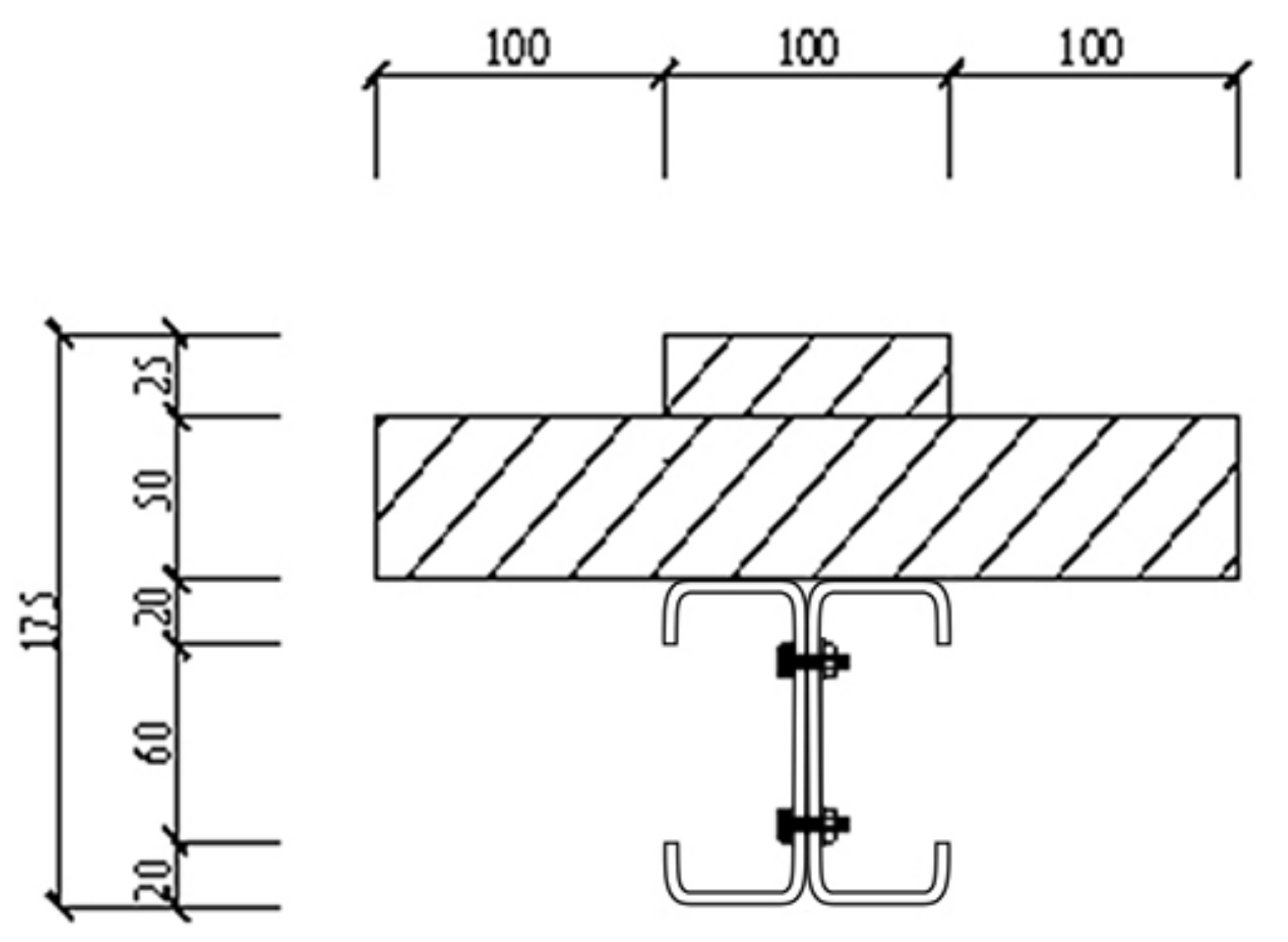
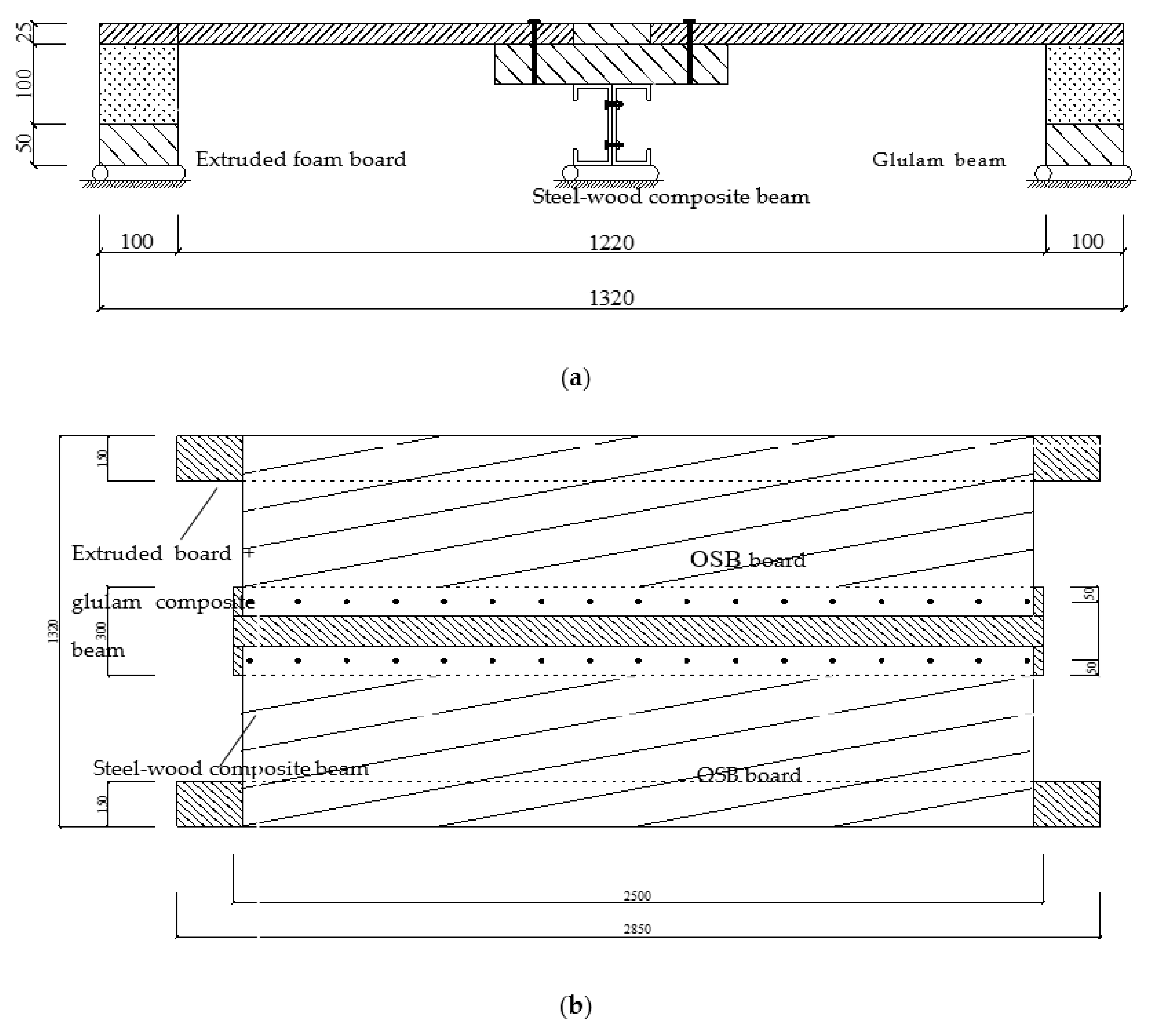
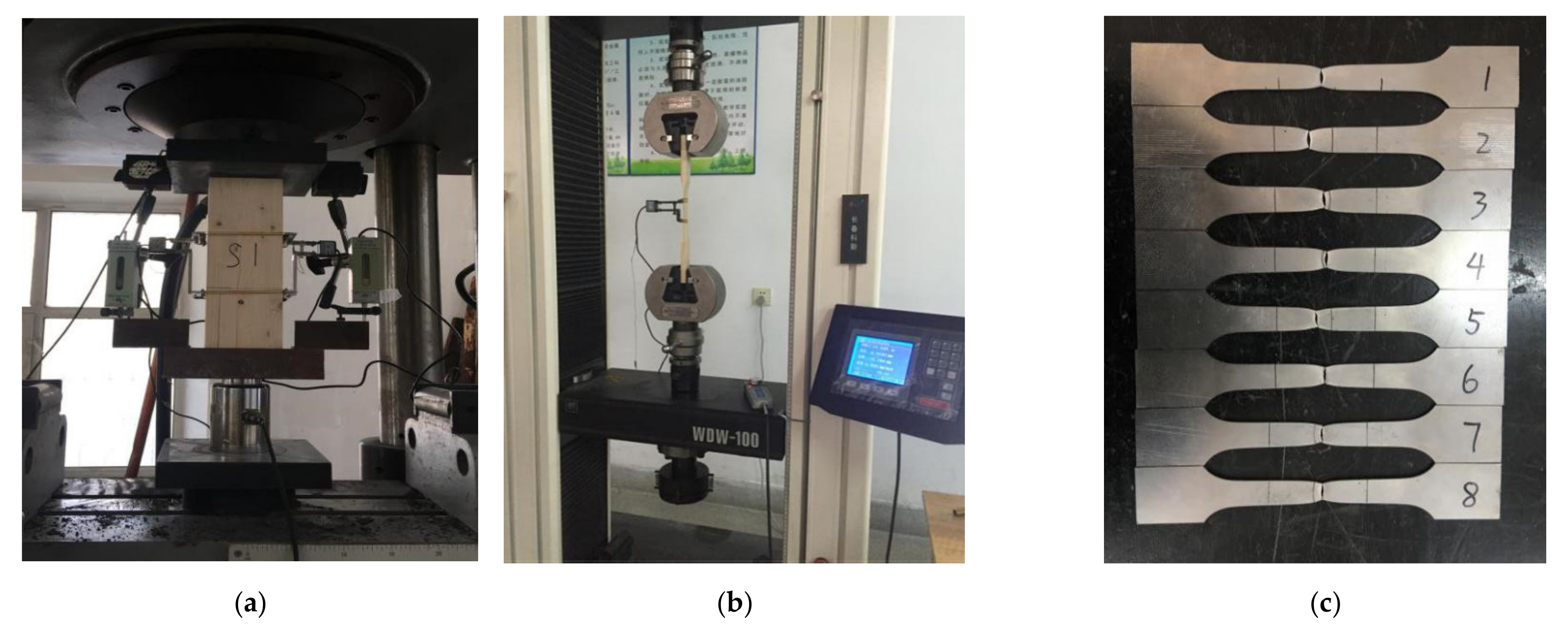
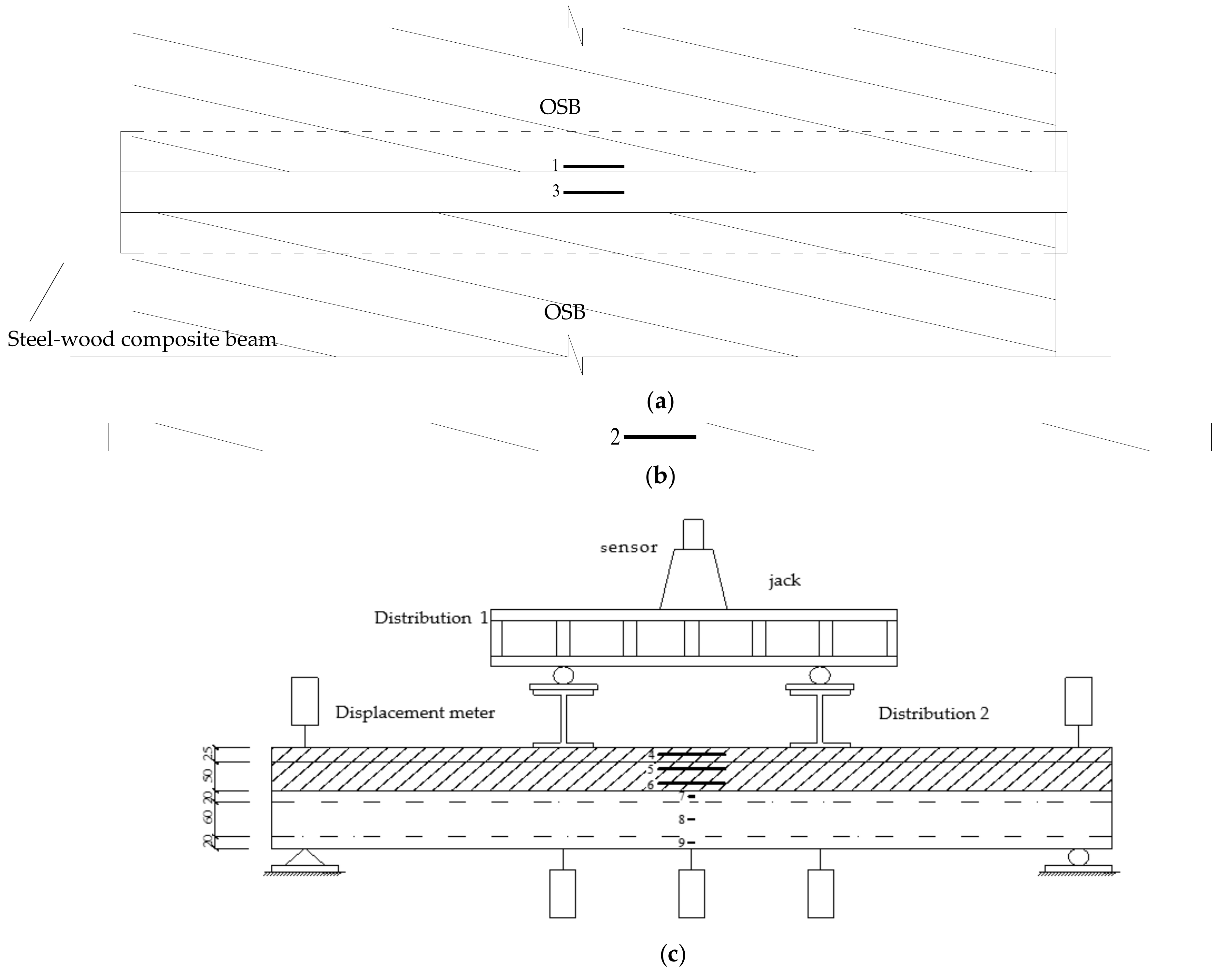
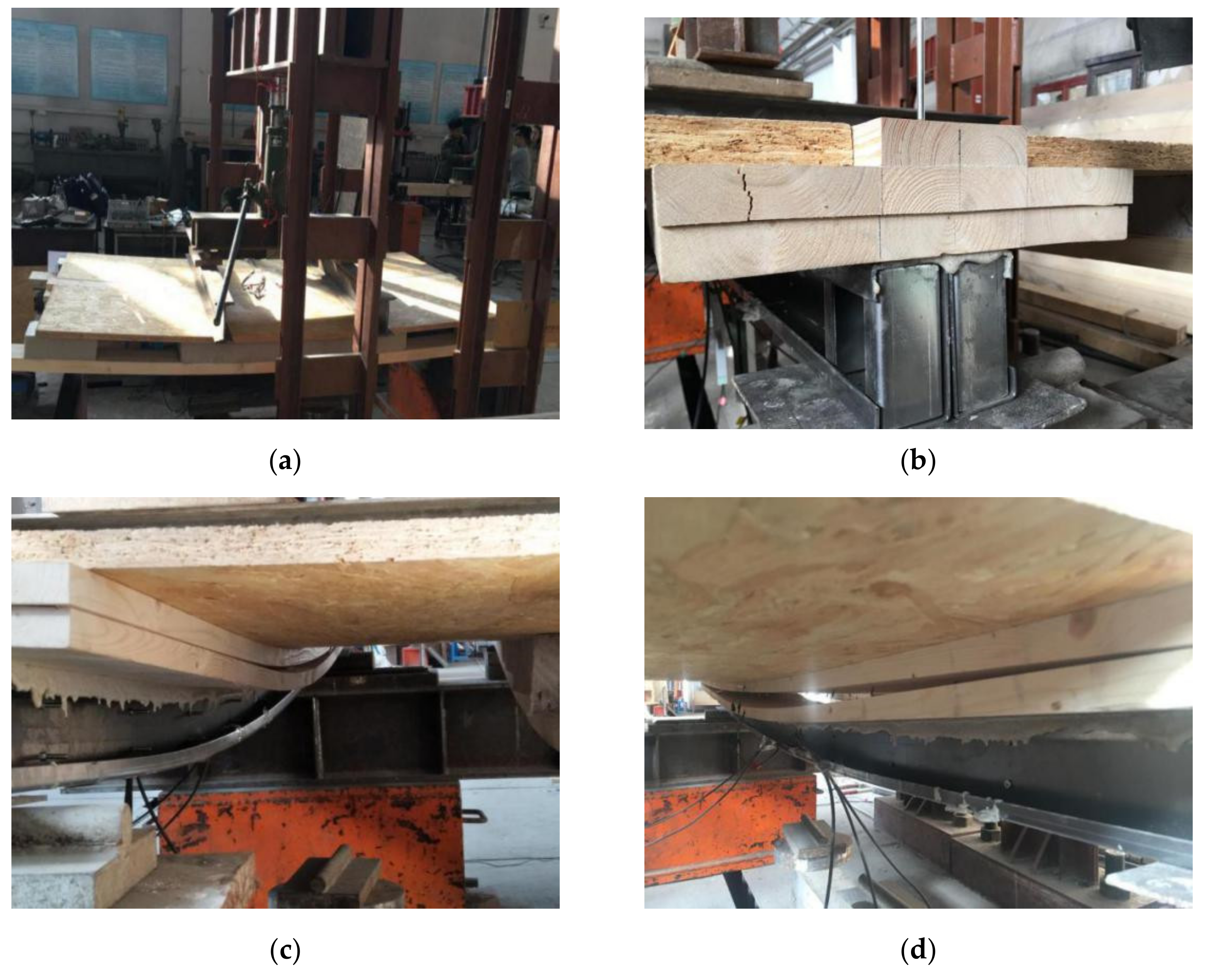


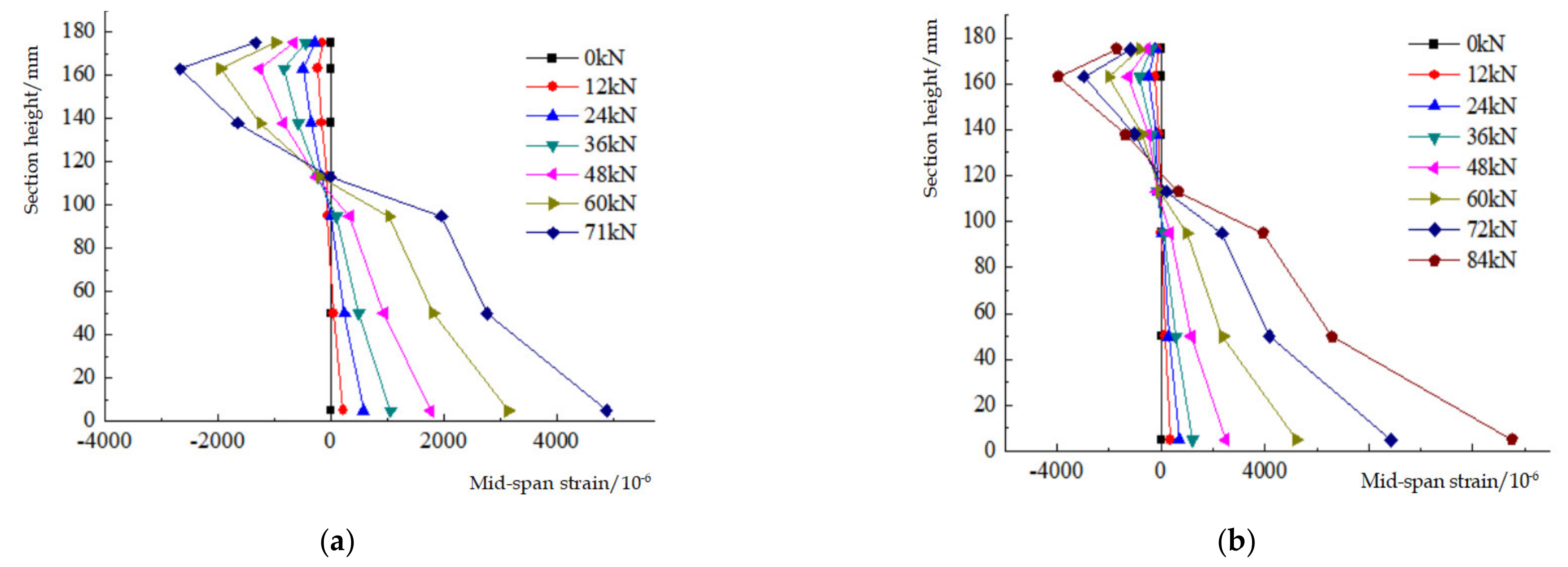
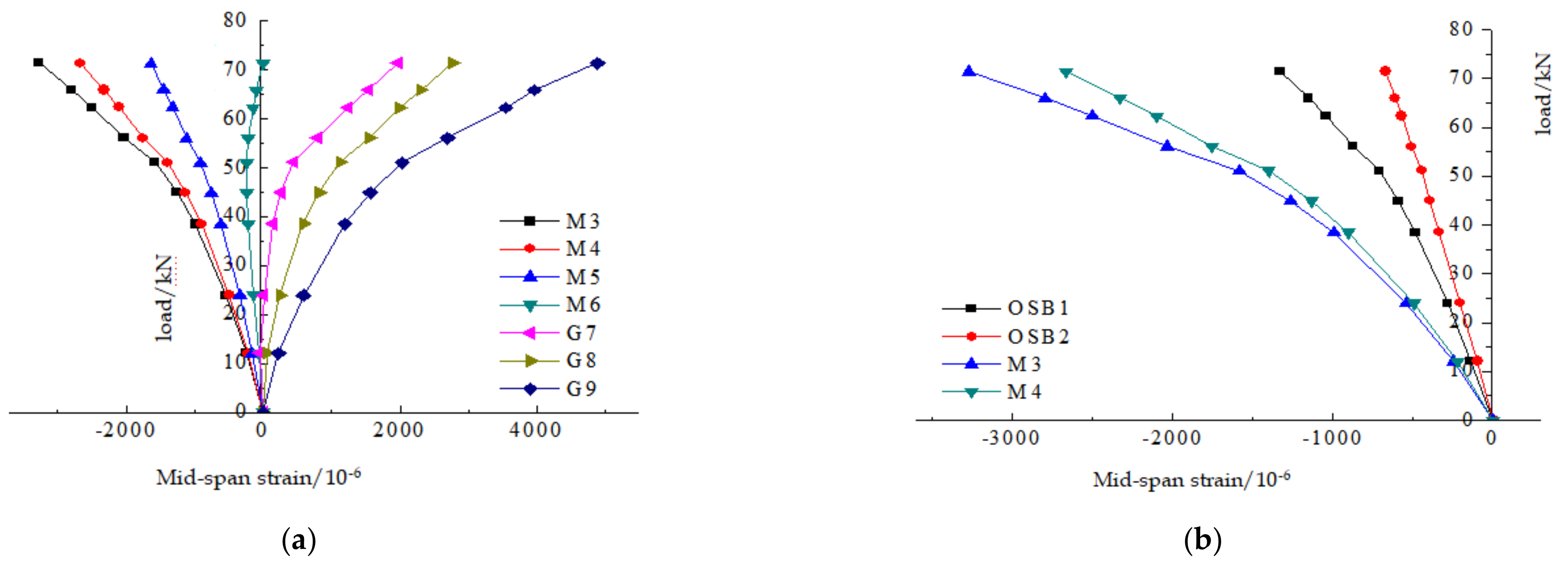


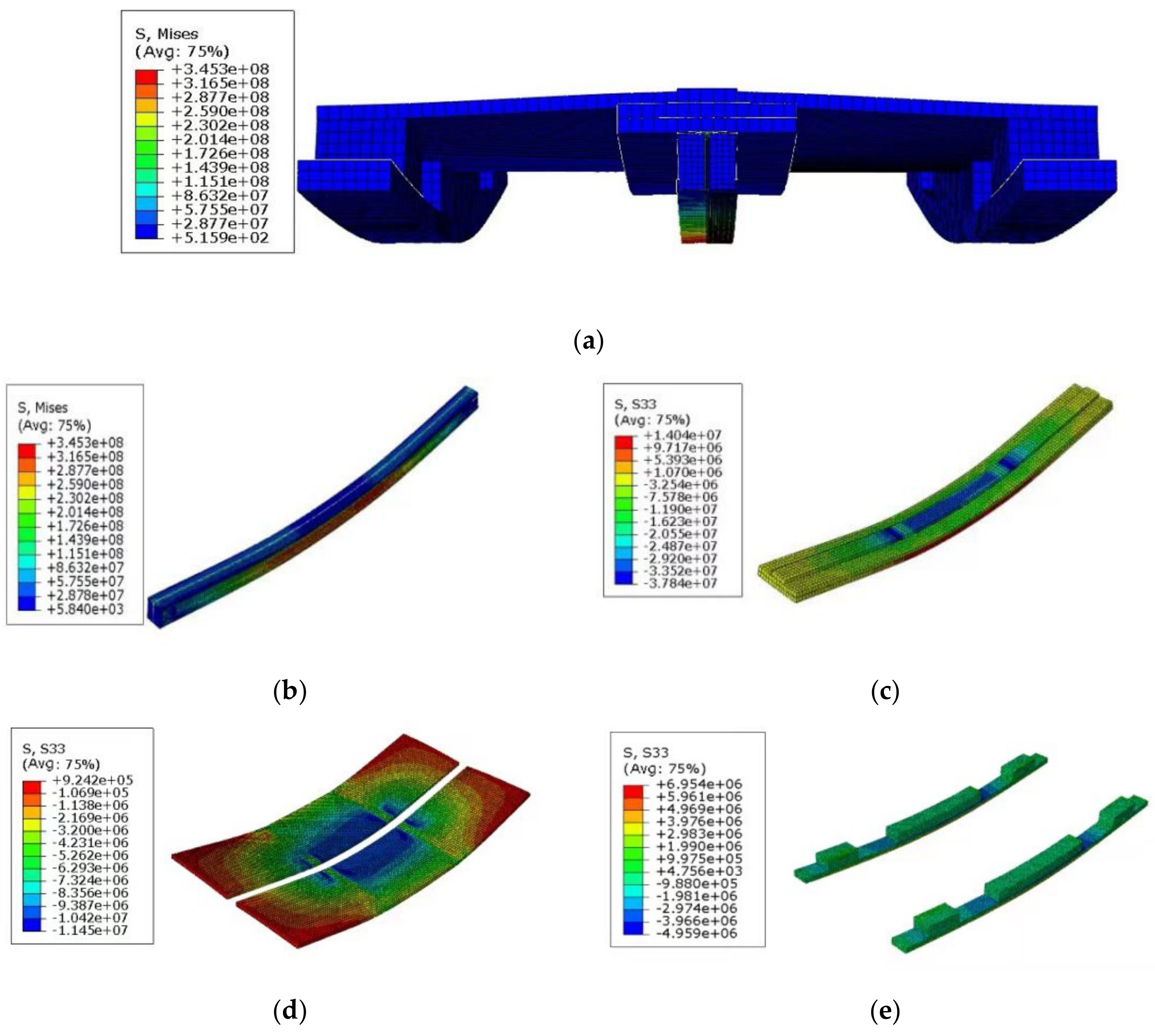
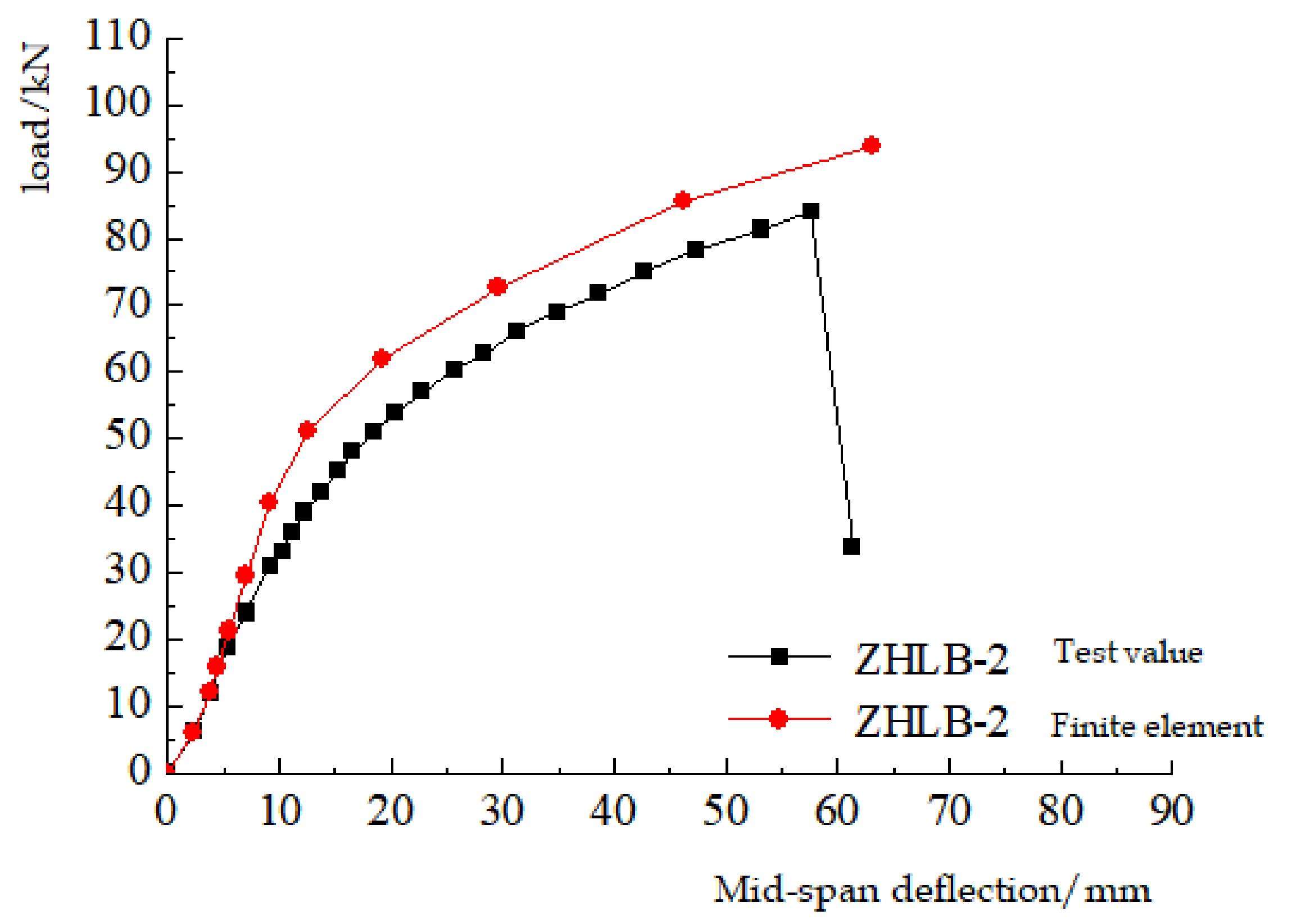
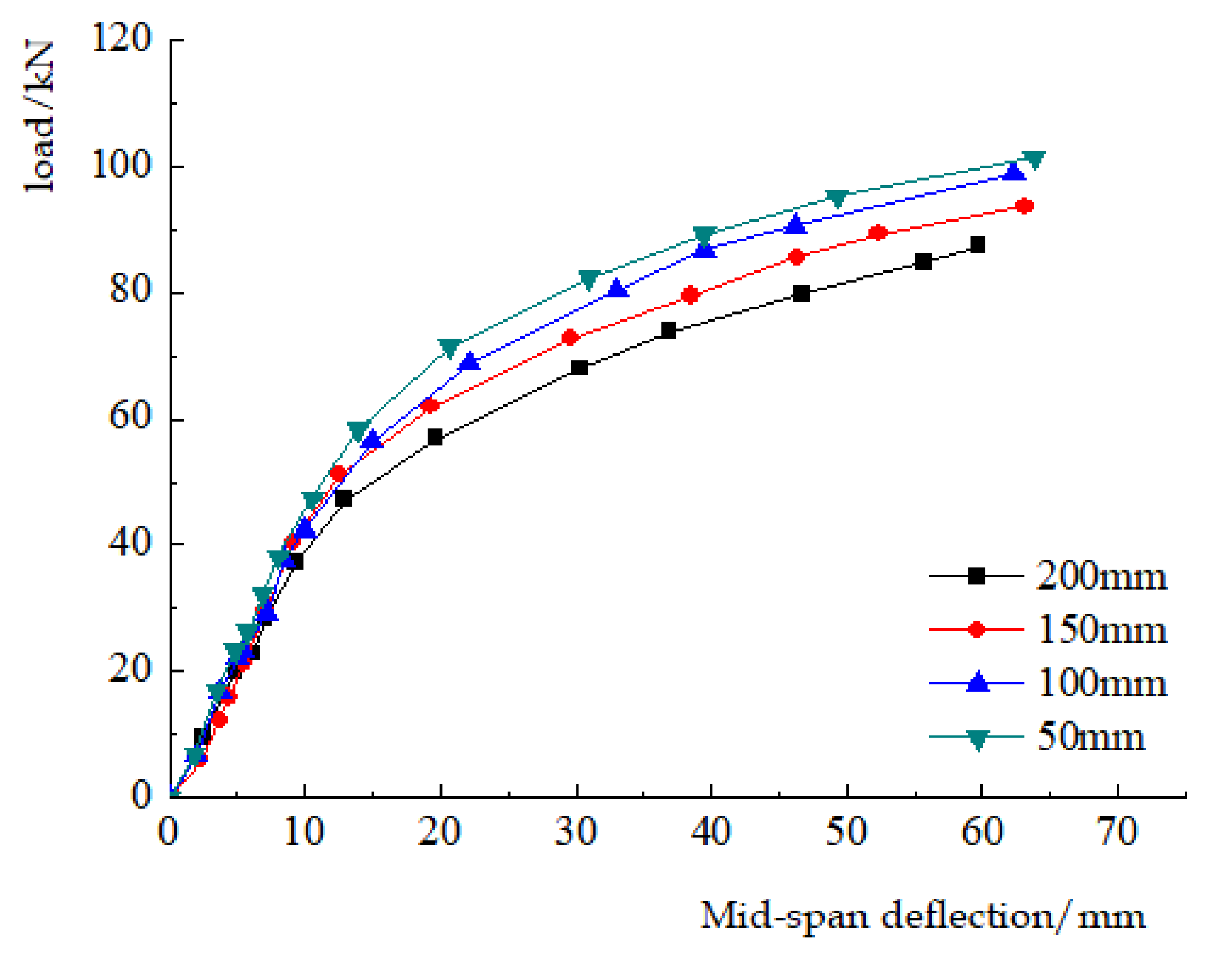
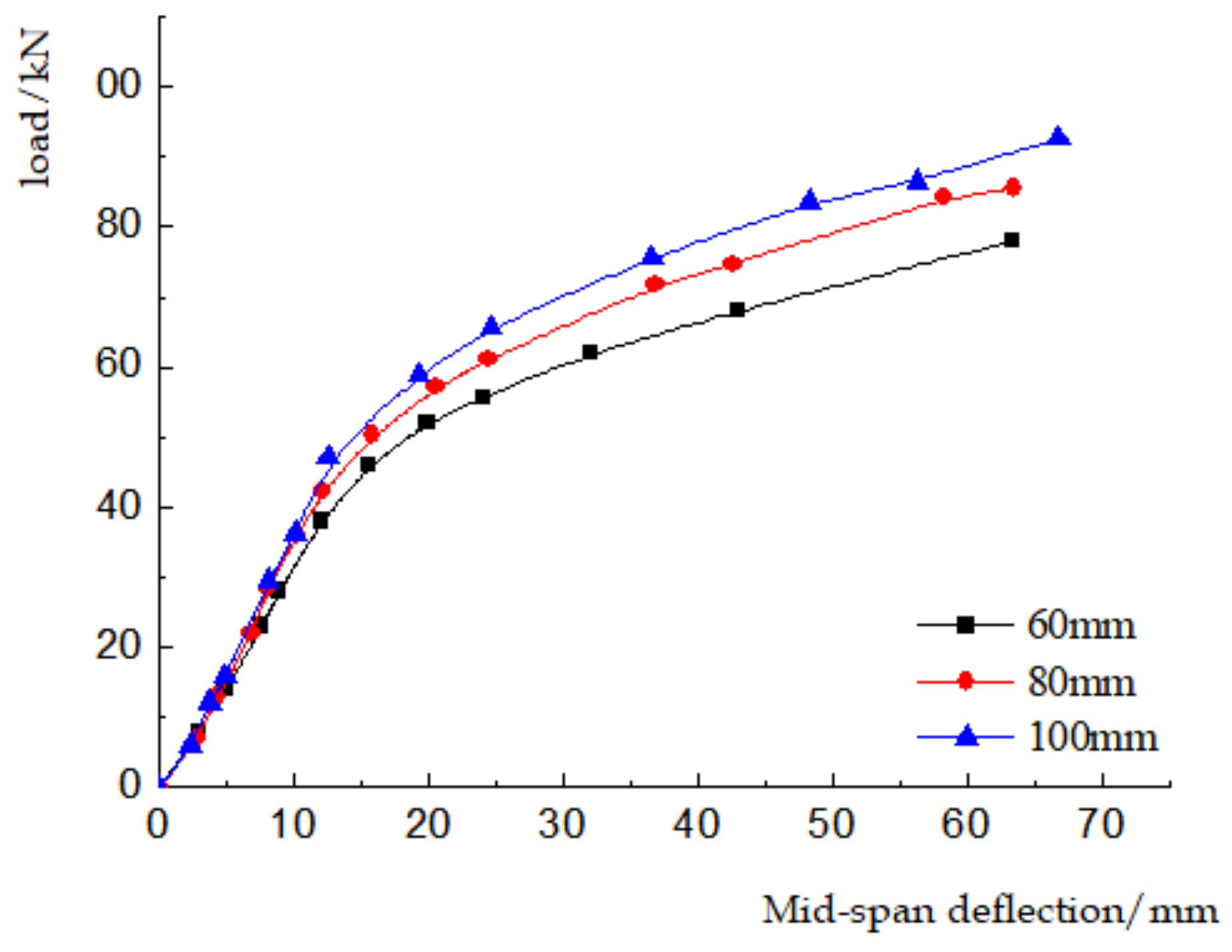
| Specimen | Glulam Section Size Length × Width × Height (mm) | Steel Beam Size (mm) | OSB Size (mm) | Connection between Plate and Beam | Superimposed Beam Cross-Section Diagram |
|---|---|---|---|---|---|
| ZHLB-1 | 2500 × 300 × 75 | 2500 mm long C100 × 50 × 20 × 2.4 | 2440 × 610 × 25 | 80 mm nails | Picture 3 |
| ZHLB-2 | 80 mm self-tapping screws |
| Material | Elastic Modulus (N/mm2) | Yield Strength (N/mm2) | Poisson’s Ratio |
|---|---|---|---|
| OSB | 4760 | 9.83 | 0.4 |
| Extruded board | 6.6 | 0.15 | 0.27 |
| Steel sticking glue | 4000 | 55 | 0.15 |
| Specimen Number | Mid-Span Deflection Limit(mm) | Maximum Deflection/Calculation Span | Ultimate Load (kN) | Bending Moment (kN·m) |
|---|---|---|---|---|
| ZHLB-1 | 40.46 | 1/59 | 71 | 28 |
| ZHLB-2 | 57.62 | 1/42 | 84 | 34 |
| D1111 (N/mm2) | D2222 = D3333(N/mm2) | D1122 = D1133 (N/mm2) | D2233 (N/mm2) | D1212 = D1313(N/mm2) | D2323 (N/mm2) |
|---|---|---|---|---|---|
| 11,532.52× 106 | 938.98 × 106 | 620.28 × 106 | 611.72 × 106 | 723.74 × 106 | 193.00 × 106 |
| Sub Option | Ultimate Load/kN | Maximum Deflection/mm | Bending Moment/kN·m |
|---|---|---|---|
| The test results | 84.03 | 57.62 | 33.61 |
| Finite element value | 93.67 | 63.16 | 37.47 |
| Error | 11.47% | 9.6% | 11.48% |
| Self-Tapping Screw Spacing (mm) | Ultimate Load Value (kN) | Compared with the Benchmark | Increase with Reduction |
|---|---|---|---|
| 200 | 87.43 | −6.67% | — |
| 150 | 93.67 | — | 7.14% |
| 100 | 98.92 | 5.60% | 5.60% |
| 50 | 101.39 | 8.24% | 2.5% |
| Glulam Flange Width (mm) | Ultimate Load Value (kN) | Increase Compared to the Benchmark | Increase by One Step |
|---|---|---|---|
| 60 | 78.04 | −16.69% | — |
| 80 | 85.23 | −9.01% | 9.21% |
| 100 | 93.67 | — | 9.90% |
Publisher’s Note: MDPI stays neutral with regard to jurisdictional claims in published maps and institutional affiliations. |
© 2021 by the authors. Licensee MDPI, Basel, Switzerland. This article is an open access article distributed under the terms and conditions of the Creative Commons Attribution (CC BY) license (https://creativecommons.org/licenses/by/4.0/).
Share and Cite
Li, G.; Liu, Z.; Tang, W.; He, D.; Shan, W. Experimental and Numerical Study on the Flexural Performance of Assembled Steel-Wood Composite Slab. Sustainability 2021, 13, 3814. https://doi.org/10.3390/su13073814
Li G, Liu Z, Tang W, He D, Shan W. Experimental and Numerical Study on the Flexural Performance of Assembled Steel-Wood Composite Slab. Sustainability. 2021; 13(7):3814. https://doi.org/10.3390/su13073814
Chicago/Turabian StyleLi, Guodong, Zhibin Liu, Wenjia Tang, Dongpo He, and Wei Shan. 2021. "Experimental and Numerical Study on the Flexural Performance of Assembled Steel-Wood Composite Slab" Sustainability 13, no. 7: 3814. https://doi.org/10.3390/su13073814
APA StyleLi, G., Liu, Z., Tang, W., He, D., & Shan, W. (2021). Experimental and Numerical Study on the Flexural Performance of Assembled Steel-Wood Composite Slab. Sustainability, 13(7), 3814. https://doi.org/10.3390/su13073814






